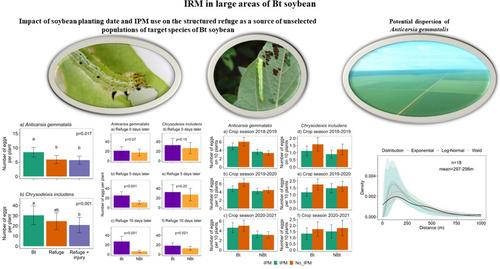当前位置:
X-MOL 学术
›
Pest Manag. Sci.
›
论文详情
Our official English website, www.x-mol.net, welcomes your feedback! (Note: you will need to create a separate account there.)
Oviposition patterns of primary lepidopteran defoliators in soybean and the impact on structured refuge recommendations
Pest Management Science ( IF 3.8 ) Pub Date : 2024-06-28 , DOI: 10.1002/ps.8277 Jaciara Gonçalves 1 , Eduardo Soares Calixto 2 , Adeney de Freitas Bueno 1, 3 , Patrick Marques Dourado 4 , Silvana V. Paula‐Moraes 2
Pest Management Science ( IF 3.8 ) Pub Date : 2024-06-28 , DOI: 10.1002/ps.8277 Jaciara Gonçalves 1 , Eduardo Soares Calixto 2 , Adeney de Freitas Bueno 1, 3 , Patrick Marques Dourado 4 , Silvana V. Paula‐Moraes 2
Affiliation

|
BACKGROUNDTransgenic Bt technology in soybean, with plants expressing Cry1Ac, has been adopted as an insect pest management tool. It was first adopted in large areas of South America and Asia in 2013. The risk of resistance in target pests to this technology demands insect resistance management (IRM) programs. In Brazil, a structured refuge (area of non‐Bt soybean) planted adjacent to the Bt soybean crop has been an important IRM recommendation, particularly for the primary lepidopteran defoliators Anticarsia gemmatalis (Lepidoptera: Erebidae) and Chrysodeixis includens (Lepidoptera: Noctuidae). The overall goal of this study was to validate IRM recommendations to Bt soybean. The objectives were to document the impact of soybean phenology, cultivar choice and non‐Bt soybean defoliation on moth oviposition. In addition, a mark‐release‐recapture study estimated the dispersal capacity of these species. Five field experiments per species were performed for 3 years.RESULTSOur results revealed an increase in A. gemmatalis and C. includens oviposition, respectively, on Bt plants as a consequence of the difference in plant growth stage at the time of oviposition. Defoliation of non‐Bt plants significantly increased the oviposition preference of both moth species for Bt plants. The mark‐release‐recapture experiment indicated an average dispersal distance of ~300 m from the release point for A. gemmatalis , with maximum recapture at 1000 m.CONCLUSIONOverall, our findings emphasize the importance of planting synchronization of Bt soybean and the structured refuge. In addition, when operational aspects in large soybean areas challenge this recommendation, the priority should be for planting the refuge area first. This approach will minimize the impact of selective oviposition of A. gemmatalis and C. includens . © 2024 Society of Chemical Industry.
中文翻译:

大豆中初级鳞翅目落叶昆虫的产卵模式及其对结构化避难所建议的影响
背景技术大豆中的转基因Bt技术,以及表达Cry1Ac的植物,已被采用作为害虫防治工具。该技术于 2013 年首次在南美和亚洲大片地区采用。目标害虫对该技术产生抗性的风险需要昆虫抗性管理 (IRM) 计划。在巴西,在 Bt 大豆作物附近种植结构化保护区(非 Bt 大豆区域)一直是 IRM 的重要建议,特别是对于主要鳞翅目落叶害虫 Anticarsia gemmatalis(鳞翅目:Erebidae)和 Chrysodeixis includens(鳞翅目:Noctuidae)。本研究的总体目标是验证 IRM 对 Bt 大豆的建议。目的是记录大豆物候、品种选择和非 Bt 大豆落叶对蛾产卵的影响。此外,一项标记-释放-重新捕获研究估计了这些物种的扩散能力。每个物种进行了 5 次田间实验,为期 3 年。结果我们的结果显示,由于产卵时植物生长阶段的差异,A. gemmatalis 和 C. includens 在 Bt 植物上的产卵量分别增加。非 Bt 植物的落叶显着增加了两种蛾类对 Bt 植物的产卵偏好。标记-释放-重新捕获实验表明,A. gemmatalis 的平均扩散距离距释放点约 300 m,最大重新捕获距离为 1000 m。 结论 总体而言,我们的研究结果强调了 Bt 大豆同步种植和结构化避难所的重要性。此外,当大面积大豆种植区的运营方面对这一建议提出挑战时,应优先考虑首先种植避难区。这种方法将最大限度地减少 A. 选择性产卵的影响。 gemmatalis 和 C. includens。 © 2024 化学工业协会。
更新日期:2024-06-28
中文翻译:

大豆中初级鳞翅目落叶昆虫的产卵模式及其对结构化避难所建议的影响
背景技术大豆中的转基因Bt技术,以及表达Cry1Ac的植物,已被采用作为害虫防治工具。该技术于 2013 年首次在南美和亚洲大片地区采用。目标害虫对该技术产生抗性的风险需要昆虫抗性管理 (IRM) 计划。在巴西,在 Bt 大豆作物附近种植结构化保护区(非 Bt 大豆区域)一直是 IRM 的重要建议,特别是对于主要鳞翅目落叶害虫 Anticarsia gemmatalis(鳞翅目:Erebidae)和 Chrysodeixis includens(鳞翅目:Noctuidae)。本研究的总体目标是验证 IRM 对 Bt 大豆的建议。目的是记录大豆物候、品种选择和非 Bt 大豆落叶对蛾产卵的影响。此外,一项标记-释放-重新捕获研究估计了这些物种的扩散能力。每个物种进行了 5 次田间实验,为期 3 年。结果我们的结果显示,由于产卵时植物生长阶段的差异,A. gemmatalis 和 C. includens 在 Bt 植物上的产卵量分别增加。非 Bt 植物的落叶显着增加了两种蛾类对 Bt 植物的产卵偏好。标记-释放-重新捕获实验表明,A. gemmatalis 的平均扩散距离距释放点约 300 m,最大重新捕获距离为 1000 m。 结论 总体而言,我们的研究结果强调了 Bt 大豆同步种植和结构化避难所的重要性。此外,当大面积大豆种植区的运营方面对这一建议提出挑战时,应优先考虑首先种植避难区。这种方法将最大限度地减少 A. 选择性产卵的影响。 gemmatalis 和 C. includens。 © 2024 化学工业协会。











































 京公网安备 11010802027423号
京公网安备 11010802027423号